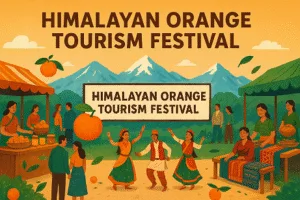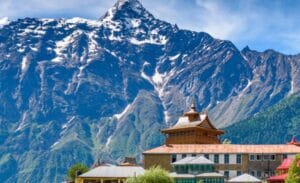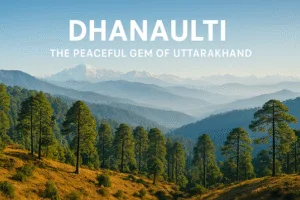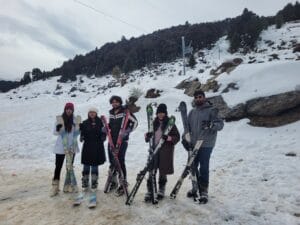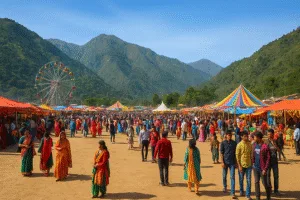Manimahesh Kailash – A Complete Pilgrimage and Trekking Guide

Mohit Bangari
Explore Himalaya With Me!!
Facebook
Email
WhatsApp
Twitter
LinkedIn
Tumblr
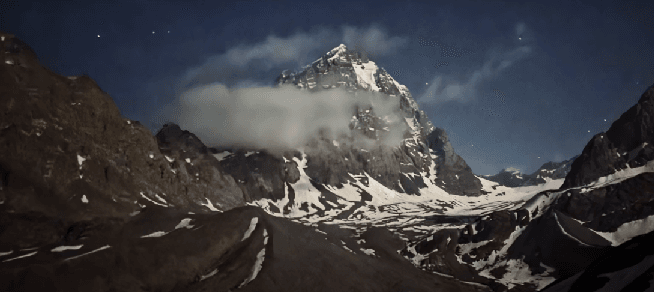
Manimahesh Kailash is one of the most sacred peaks of the Panch Kailash. Located in the Pir Panjal range of Himachal Pradesh, it rises to an altitude of 5,653 metres (18,547 ft). At its base lies the holy Manimahesh Lake (4,080 m / 13,390 ft), which holds immense religious significance for Hindus.
This place is not only a spiritual destination but also a trekking paradise. The serene lake, mighty snow-clad peak, and stories connected with Lord Shiva make it a unique journey where faith and adventure meet.
To understand the full spiritual picture, one must know about Panch Kailash, the five divine abodes of Lord Shiva in Himalayas. I have written a dedicated article on this topic where I have shared complete details of all five Kailash yatras. You can read it here – Panch Kailash: A Complete Guide to the Abodes of Lord Shiva.
Table of Contents
Location and Coordinates
District: Chamba, Himachal Pradesh
Nearest Town: Bharmour (32.4411° N, 76.5436° E)
Hadsar (Starting point): 32.4917° N, 76.6353° E
Manimahesh Lake: 32.5072° N, 76.6247° E
Manimahesh Kailash Peak: 32.5094° N, 76.6283° E
The lake is about 13 km trek from Hadsar and is surrounded by high Himalayan ridges.
Mythological Significance
According to local belief, Lord Shiva resides on Manimahesh Kailash after his marriage with Goddess Parvati. The word “Manimahesh” means “Shiva’s Jewel.” It is believed that a shining gem is placed on the peak which reflects divine light on moonlit nights.
Local people also say that anyone who tries to climb the peak faces obstacles. Many mountaineers have attempted but none succeeded, and it is considered unclimbable due to Shiva’s protection.
The holy Manimahesh Lake was created by Shiva himself. Bathing in this lake during the yatra is believed to wash away sins.
Read Also – Shrikhand Mahadev Kailash
– A Complete Detailed Guide 2025-26
Shrikhand Mahadev trek is one of the toughest yet m
ost divine yatras in Himachal. My detailed
guide explains the route, legends, Nainsarovar, and best time to vi
sit. A must-read for devotees of Bholenath.
Click Here
Routes to Manimahesh Kailash
There are two main trekking routes to reach the lake. Both routes are considered sacred and have different experiences.
1. Hadsar Route (Traditional Route)
This is the most popular route for both pilgrims and trekkers.
Route Details:
Bharmour (2,195 m / 7,201 ft) to Hadsar (2,350 m / 7,710 ft) – 13 km by road.
Hadsar to Dhancho (3,170 m / 10,400 ft) – 6 km trek, steep forest climb.
Dhancho to Sundrasi (3,650 m / 11,975 ft) – 3 km trek, meadows and waterfalls.
Sundrasi to Manimahesh Lake (4,080 m / 13,390 ft) – 4 km steep trek, rocky terrain.
Total Trek Distance: 13 km (one side)
Total Trek Time: 6–8 hours
Itinerary (Hadsar Route):
Day 1: Bharmour to Hadsar by road. Trek to Dhancho. Stay at camps/lodges.
Day 2: Dhancho to Manimahesh Lake via Sundrasi. Same day return to Dhancho or camp near lake.
Day 3: Trek back to Hadsar, return to Bharmour.
This route is easier compared to Kugti and is best for families and pilgrims. During the Manimahesh Yatra (August–September), the path is crowded but full of energy with langars and camps on the way.
Read Also – Adi Kailash Yatra 2025-26 Itinerary
Adi Kailash is also known as Chhota Kailash, a sacred place near Om Parvat.
I have shared a complete day-wise itinerary,
stay options, and travel tips for the 2025-26 yatra.
Click Here
2. Kugti Route (Tough and Scenic Route)
This is a more challenging trek that starts from Kugti village, one of the highest inhabited villages in Himachal. It is less crowded and offers raw Himalayan beauty.
Route Details:
Bharmour to Kugti village (2,600 m / 8,530 ft) – 24 km by road.
Kugti to Hadsar Top / Alyas (4,100 m / 13,450 ft) – 14 km trek, tough ascent, alpine forests.
Alyas to Manimahesh Lake (4,080 m / 13,390 ft) – 8 km trek, crossing ridges and glaciers.
Total Trek Distance: 22 km (one side)
Total Trek Time: 3–4 days
Itinerary (Kugti Route):
Day 1: Bharmour to Kugti village by road. Stay in homestay.
Day 2: Trek from Kugti to Alyas (base camp).
Day 3: Alyas to Manimahesh Lake, darshan, return to Alyas.
Day 4: Trek back to Kugti, then drive to Bharmour.
This route is mostly taken by trekkers who want adventure along with pilgrimage. The landscape is more wild and untouched compared to Hadsar.
Manimahesh Yatra
The official Manimahesh Yatra takes place every year from Krishna Janmashtami to Radha Ashtami (August–September). The Himachal government and local communities arrange camps, medical support, and langars.
Two main yatras are held:
Chhari Yatra: The holy stick of Lord Shiva is carried from Bharmour to the lake.
Jatra Yatra: Thousands of devotees walk in groups chanting Shiva’s name.
Read Also – Kailash Mansarovar Yatra via
Kumaon Corridor Resumes in 2025
The Kumaon corridor route to Kailash Mansarovar has resumed in
2025 after five years. My article covers permits,
route details, safety tips, and how devotees can now easily reach this holy place.
Click Here
Best Time to Visit
June to September: Best for trekking (clear weather, open trails).
August–September: Best for pilgrimage (during official yatra).
October onwards: Heavy snowfall closes the route.
How to Reach Manimahesh Kailash
By Air: Nearest airport is Gaggal (Kangra) – 170 km from Bharmour.
By Train: Nearest railhead is Pathankot – 160 km from Chamba.
By Road: Chamba to Bharmour (65 km), then to Hadsar (13 km) or Kugti (24 km).
Facilities on the Route
During yatra, free food (langars) is provided at Dhancho and Sundrasi.
Tents and lodges are available at Bharmour, Hadsar, Dhancho, and Kugti.
Ponies and palanquins are available for old age pilgrims.
Food and Accommodation in Manimahesh Kailash Yatra
Food and stay are two big concerns when people plan for Manimahesh Kailash Yatra or Trek. Luckily, both routes – Hadsar and Kugti – have arrangements, but the facilities differ depending on whether you go during the official yatra season (August–September) or off-season (June–July).
Food Options
1. During Yatra Season (August–September)
The whole route is lined with Langars (free community kitchens) run by devotees, local people, and religious groups.
Langars provide simple vegetarian food like dal, rice, chapati, tea, and sometimes sweets like halwa.
At Dhancho and Sundrasi, big langars run day and night to serve pilgrims.
Pilgrims usually depend on langar food as it is fresh, free, and served with devotion.
2. Off-Season Food Availability
Outside the yatra season, only tea stalls, small dhabas, and local shops remain open at Bharmour, Hadsar, and Kugti.
On the trekking route, there are very few options. So trekkers carry dry fruits, biscuits, instant noodles, and energy snacks.
Local homestays in Bharmour and Kugti serve Himachali food like rajma-chawal, siddu, madra, and local breads.
3. Tips for Food
Always keep some dry snacks and water bottle handy during trek.
Avoid carrying oily food or liquor, as both are restricted in yatra.
Drink only boiled or filtered water, as stomach infections are common due to altitude.
Read Also – Kinnaur Kailash vs Adi
Kailash – Which One to Visit?
Confused between Kinnaur Kailash and Adi Kailash?
I have explained the difference in trek, culture, difficulty,
and spiritual meaning so you can decide which one fits your plan.
Click Here
Food Costs
1. During Yatra Season (August–September)
Most of the food on the route is free because of Langars (community kitchens).
Langars provide simple vegetarian meals like dal–chawal, roti–sabzi, tea, and halwa.
If you buy food from stalls/dhabas, it costs around ₹80–₹150 per plate.
Tea, snacks, and Maggi cost around ₹30–₹60 on trek route.
2. Off-Season Food
Only a few tea stalls and dhabas remain open.
In Bharmour and Kugti, homestays and lodges serve Himachali food.
Average cost for meals: ₹200–₹300 per person per day (including breakfast, lunch, dinner).
Trekkers often carry dry fruits, biscuits, and ready-to-cook food.
💰 Daily Food Cost Estimate:
Yatra Season: ₹100–₹200 (or free if you eat in langars).
Off-Season: ₹200–₹400 per person.
Accommodation Options
1. At Bharmour (Base Town)
Bharmour has the best accommodation options compared to Hadsar or Kugti.
You will find budget hotels, small guest houses, and PWD rest houses.
Prices range from ₹800–₹2000 per night depending on facilities.
Many locals also offer homestay experience, where you can enjoy local food and culture.
2. At Hadsar (Starting Point)
Hadsar has limited options as it is a small village.
Some basic lodges and dhabas provide rooms and food.
During yatra, tents are pitched in open grounds for pilgrims.
It is better to stay in Bharmour and start trek early next day.
3. On Trek Route (Hadsar – Dhancho – Sundrasi – Lake)
Dhancho (3,170 m): This is the main night halt for pilgrims. Many tent accommodations, dhabas, and langars are set here. Price for tents varies from ₹300–₹800 per bed.
Sundrasi (3,650 m): Small meadow with limited camping space. Mostly langar tents are available here during yatra.
Near Manimahesh Lake (4,080 m): Tents are pitched near the lake. It gets very cold at night, so carry extra warm clothes. During yatra, accommodation fills up fast.
4. On Kugti Route
Kugti Village: Homestays available in traditional wooden houses. Staying here gives a feel of Himalayan culture. Cost is ₹500–₹1500 including food.
Alyas (Base camp at 4,100 m): Tents are pitched by locals and some NGOs. Facilities are very basic. Food is simple (dal, rice, chapati).
Lake area: Same as Hadsar route – tents and langars during yatra, self-camping option otherwise.
Accommodation Costs
1. Bharmour (Base Town)
Hotels, guest houses, and homestays available.
Price range: ₹800–₹2000 per room per night.
Homestays including meals: around ₹1200–₹1500 per person per night.
2. Hadsar (Starting Point)
Few lodges and dhabas provide basic rooms.
Cost: ₹500–₹1000 per night.
Not many options, so many pilgrims stay in Bharmour instead.
3. On Trek Route (Hadsar – Dhancho – Sundrasi – Lake)
Dhancho (3,170 m): Tents and dhabas. Stay cost: ₹300–₹800 per bed in shared tents.
Sundrasi (3,650 m): Limited tented accommodation, mostly during yatra. Cost: ₹300–₹600 per bed.
Near Manimahesh Lake (4,080 m): Camps during yatra season. Cost: ₹500–₹1000 per bed. Off-season, only self-camping works.
4. Kugti Route
Kugti Village (2,600 m): Homestays available. Cost: ₹500–₹1500 per person including meals.
Alyas (4,100 m): Tent accommodation, very basic. Cost: ₹300–₹700 per bed.
Near Lake: Same as Hadsar route – ₹500–₹1000 per bed during yatra.
💰 Daily Stay Cost Estimate:
Budget camping/tents: ₹300–₹700 per person.
Homestays: ₹800–₹1500 including food.
Hotels (Bharmour): ₹1000–₹2000 per night.
Suggested Budget Per Day
During Yatra Season (if eating langar & staying in tents): ₹500–₹800 per person.
During Yatra Season (if staying in better camps/lodges): ₹1000–₹1500 per person.
Off-Season Trekking (with homestay or camping): ₹1200–₹2000 per person.
Suggested Stay Plan (Itinerary-wise)
Day 0 (Chamba/Bharmour) – Stay in hotel or homestay at Bharmour for acclimatization.
Day 1 (Hadsar/Kugti) – If on Hadsar route, trek till Dhancho and stay in camp. If on Kugti route, stay in Kugti homestay.
Day 2 (Manimahesh Lake) – Stay in tent near the lake or return to Dhancho. On Kugti route, stay at Alyas.
Day 3 (Return) – Return trek and stay again at Bharmour.
My Suggestions for Food & Stay
For families and senior citizens, best is to stay in Bharmour and trek with small halts.
For trekkers, camping gear can be carried if going off-season.
If you are going only for darshan in Yatra season, langars and tents are enough, no need to book separately.
Complete Budget for Manimahesh Yatra (3–4 Days from Bharmour)
The cost of Manimahesh Kailash Yatra depends on the route you choose (Hadsar route or Kugti route), type of stay (tent, homestay, hotel), and whether you are travelling in Yatra season (Aug–Sep) or off-season.
Below is a practical cost breakdown for a normal 3–4 day itinerary:
1. Travel Costs (Bharmour to Base Points)
Chamba to Bharmour (65 km): Shared taxi/bus ₹100–₹200 per person | Private taxi ₹2000–₹2500
Bharmour to Hadsar (13 km): Shared jeep ₹50 per person | Private taxi ₹600–₹800
Bharmour to Kugti (24 km): Shared jeep ₹100–₹150 per person | Private taxi ₹1200–₹1500
2. Trekking and Pilgrimage Costs
Hadsar Route (13 km trek one side)
On foot: Free, just your energy.
Pony charges: ₹1000–₹1500 one way (₹2000–₹2500 return).
Palanquin (doli) charges: ₹4000–₹6000 one way (depends on number of carriers and distance).
Kugti Route (22 km trek one side)
Pony charges: ₹1500–₹2000 one way.
Palanquin (very rare here): ₹5000–₹7000.
On foot: Free, but more challenging.
3. Food Costs
Yatra season: Mostly free (langars everywhere). If buying from stalls, around ₹100–₹200 per day.
Off-season: Meals in homestays or dhabas ₹200–₹400 per day.
4. Stay Costs
Bharmour hotels/guest houses: ₹800–₹2000 per room/night.
Hadsar basic lodges: ₹500–₹1000 per room/night.
Dhancho/Sundrasi tents: ₹300–₹800 per bed.
Near Lake: ₹500–₹1000 per bed in tents (only during yatra).
Kugti homestays: ₹500–₹1500 per person including food.
Alyas camp (Kugti route): ₹300–₹700 per bed.
5. Miscellaneous Costs
Stick/umbrella purchase: ₹100–₹200
Raincoat/poncho: ₹200–₹400
Woollen socks/cap/gloves: ₹200–₹500 (if bought locally)
Prasad and puja items: ₹100–₹200
Photography/selfie charges with locals’ yak/pony (optional): ₹50–₹100
Read Also – Kailash Mansarovar – A Detailed Guide
Kailash Mansarovar is the most sacred yatra for Hindus,
Buddhists, and Jains. My guide shares travel routes,
permits, costs, and spiritual meaning of this holy journey in detail.
Click Here
Sample Budget (Per Person for 3–4 Days Trip)
Option 1 – Budget Pilgrim (Hadsar Route, Yatra Season, walking, using tents/langars)
Travel (Chamba–Bharmour–Hadsar–return): ₹500–₹700
Food (langars/free, snacks only): ₹200–₹300
Stay (tents/lodges): ₹600–₹1500 (2 nights)
Miscellaneous: ₹300–₹400
➡ Total: ₹1600–₹2900 per person
Option 2 – Comfortable Pilgrim (Hadsar Route, pony ride, hotel stay at Bharmour)
Travel: ₹1000–₹1500
Pony charges: ₹2000–₹2500
Food: ₹400–₹600
Stay: ₹2500–₹3500 (2–3 nights in hotel/tents)
Miscellaneous: ₹500
➡ Total: ₹6400–₹8600 per person
Option 3 – Trekker (Kugti Route, homestays + camping, off-season)
Travel: ₹1200–₹1800
Food: ₹600–₹1000 (homestays/dhabas)
Stay: ₹1800–₹2500 (3 nights homestay + tents)
Miscellaneous: ₹500
➡ Total: ₹4100–₹5800 per person
Key Budget Tips
If you are on a tight budget, choose the Hadsar route, depend on langars, and use tents.
For a family trip, staying in Bharmour hotels and hiring ponies is more comfortable.
Kugti route is for adventure lovers; budget is slightly higher due to less facilities.
Always carry some cash (₹2000–₹3000 per person) as ATMs are only in Chamba and Bharmour.
Other Attractions Around Manimahesh
Chaurasi Temple Complex (Bharmour) – 84 ancient temples.
Kugti Wildlife Sanctuary – home to Himalayan tahr, musk deer, and rare birds.
Chamba Town – rich culture, traditional handicrafts, and museums.
Things to Carry
Woollen clothes, gloves, cap, socks
Trekking shoes with good grip
Raincoat and walking stick
Personal medicines, sunscreen, first aid kit
Dry fruits, chocolates, water bottle
FAQs about Manimahesh Kailash
Q. How far is Manimahesh Lake from Bharmour?
Around 26 km (13 km by road to Hadsar + 13 km trek).
Q. Can women visit Manimahesh Lake?
Yes, women can visit and worship at the lake. Only climbing the peak is restricted by belief.
Q. Which route is easier – Hadsar or Kugti?
Hadsar route is shorter and easier, suitable for families. Kugti route is longer and tougher, suitable for trekkers.
Q. Is camping allowed at the lake?
Yes, but during yatra days it gets crowded. Camps are set up at Sundrasi and near the lake.
Q. Can we see the reflection of the peak in the lake?
Yes, on clear days, the peak’s reflection in the lake is considered the true darshan of Lord Shiva.
Conclusion
Manimahesh Kailash is a blend of spirituality and Himalayan adventure. Whether you choose the traditional Hadsar route or the challenging Kugti route, the journey is filled with natural beauty and deep devotion. The holy Manimahesh Lake with the towering Kailash peak above is one of the most sacred experiences in the Himalayas.
– Mohit Bangari
You can also explore more on Himalayan treks like Darma Valley, Adi Kailash, and others on my website mohitbangari.com, where I share full guides, routes, permit tips and cultural info.
Do you know about Ramman festival of Salud-Dungra village? It’s one of the intangible world cultural heritage of India in UNESCO. You can read a detailed article on this topic here.
Facebook
Email
WhatsApp
Twitter
LinkedIn
Tumblr
Related Post
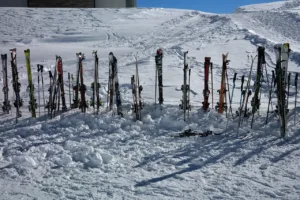
Adventure
Mohit Bangari
30 November 2025

Mohit Bangari
Explore Himalaya With Me!!


Explore the beauty and cultures of the Himalayas, from Jammu and Kashmir to Arunachal Pradesh, Tibet and Nepal. My blog shares stories, pictures, and fun articles about this amazing region. Come along on a journey where each mountain has a tale and every valley hides a treasure. Join me as I discover the magic of the mountains together.
Welcome to my Himalayan Adventure!

